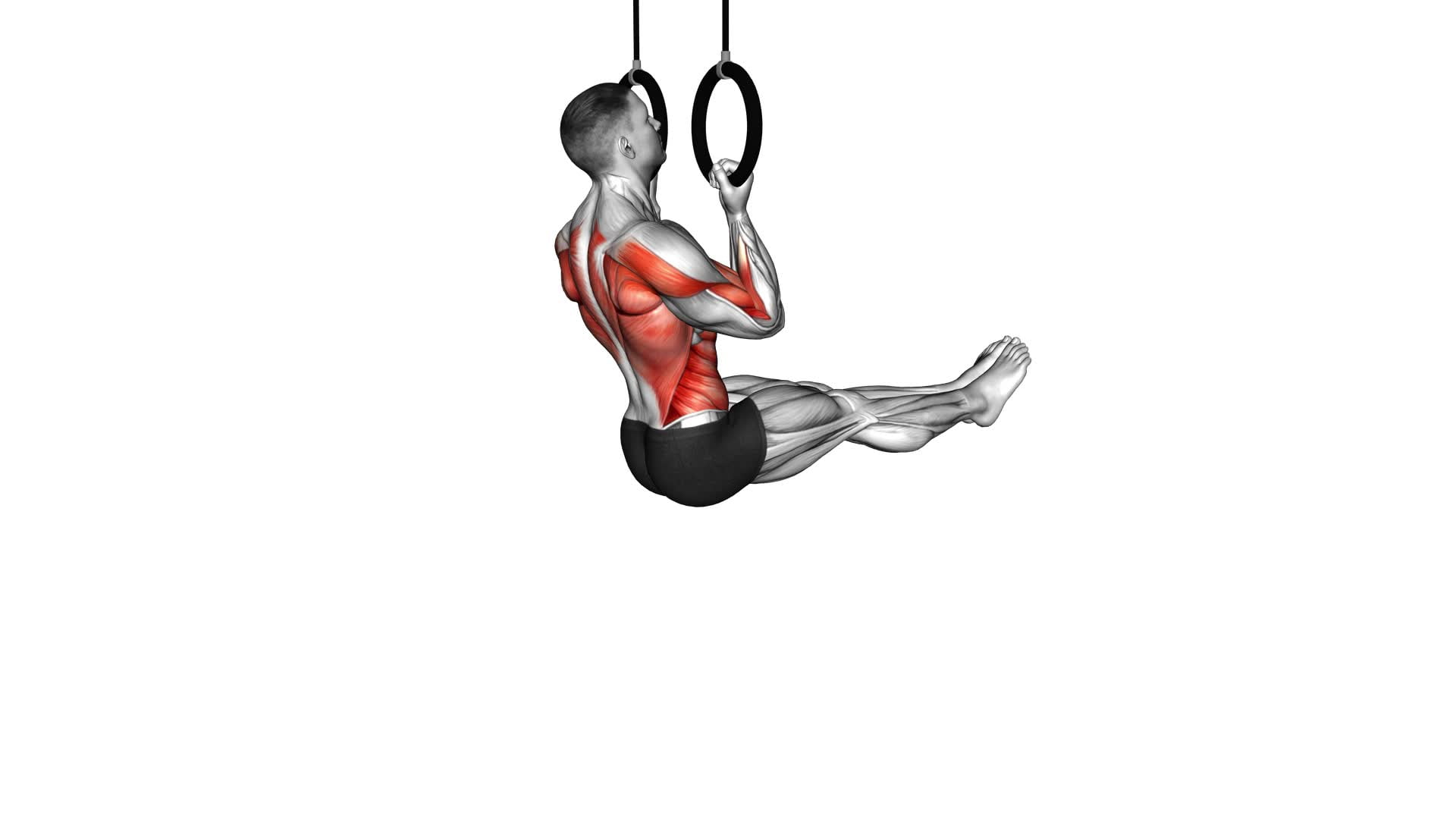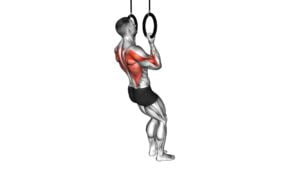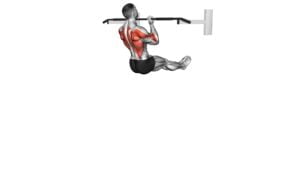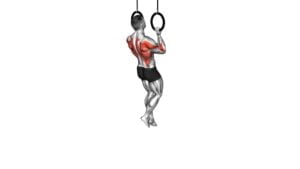Ring L-Sit Chin-up (male) – Video Exercise Guide & Tips

Are you looking to strengthen your upper body and core? Then the Ring L-Sit Chin-up is the exercise for you!
Watch This Exercise Video
In this video exercise guide, you'll discover how to properly perform this challenging move. Whether you're a beginner or advanced, we'll provide progressions and variations to suit your fitness level.
Avoid common mistakes and maximize your results with our helpful tips. Get ready to take your chin-up game to new heights!
Key Takeaways
- Ring L-Sit Chin-up targets multiple muscle groups simultaneously.
- Proper form and technique are crucial for maximizing results and reducing the risk of injury.
- Progressions and advanced variations can help beginners build strength and skill over time.
- Incorporating progressive overload techniques and prioritizing recovery are essential for continued progress and muscle growth.
Benefits of the Ring L-Sit Chin-up
The Ring L-Sit Chin-up offers numerous benefits for your upper body strength and core stability. Incorporating variations of the Ring L-Sit Chin-up into your workout routine can help you achieve maximum results.
One of the main benefits of the L-Sit Chin-up is its ability to target multiple muscle groups simultaneously. By engaging your back, biceps, shoulders, and core, this exercise provides a comprehensive upper body workout.
The L-Sit Chin-up also helps to improve your grip strength, as you're required to hold onto the rings throughout the movement. Additionally, this exercise promotes better posture and spinal alignment. By engaging your core and pulling your shoulders back, you develop a strong and stable upper body, which can help prevent injuries and discomfort.
The L-Sit Chin-up also offers variations that allow you to adjust the difficulty level to suit your fitness level. Whether you're a beginner or an advanced athlete, there's a variation of the L-Sit Chin-up that can challenge and strengthen your upper body effectively.
Incorporating the Ring L-Sit Chin-up into your workout routine can lead to significant improvements in your upper body strength and core stability.
Proper Form and Technique
To perform the Ring L-Sit Chin-up with proper form and technique, there are a few key points to keep in mind.
First, ensure a secure grip and hand placement on the rings, maintaining a firm hold throughout the exercise.
Second, engage your core muscles to maintain stability and prevent any swinging motions.
Lastly, be mindful of avoiding any swinging or momentum-based movements during the exercise, as this can compromise the effectiveness of the workout.
Grip and Hand Placement
Choose the right grip and hand placement to ensure proper form and technique during the Ring L-Sit Chin-up exercise. The hand grip is an essential factor in executing this exercise correctly. Here are three key points to consider when it comes to grip and hand placement:
- Use an overhand grip: Place your hands on the rings with your palms facing away from you. This grip allows for a solid hold and engages the muscles in your back and arms effectively.
- Maintain a shoulder-width hand placement: Position your hands slightly wider than shoulder-width apart. This width provides stability and allows for proper engagement of the upper body muscles.
- Ensure a neutral wrist position: Keep your wrists straight and aligned with your forearms. Avoid bending or flexing your wrists to prevent strain or injury.
Engaging the Core
Maintain proper form and technique by engaging your core during the Ring L-Sit Chin-up exercise. Engaging your core is crucial for core stability and maximizing abdominal strength during this exercise.
To engage your core, start by contracting your abdominal muscles and pulling your belly button towards your spine. This will help stabilize your torso and keep your body in a straight line throughout the movement. By actively engaging your core, you'll not only improve your overall stability, but also enhance your performance and prevent any unnecessary strain on your lower back.
Now that you know how to engage your core properly, let's move on to the next section about avoiding swinging motions, which can compromise your form and hinder your progress.
Avoiding Swinging Motions
Engage your body's core muscles to maintain stability and prevent swinging motions during the Ring L-Sit Chin-up exercise. Avoiding swinging is crucial for building upper body strength effectively.
Here are three reasons why you should focus on avoiding swinging motions:
- Increased muscle activation: By eliminating swinging, you force your targeted muscles, such as the biceps and latissimus dorsi, to work harder. This leads to greater muscle activation and faster strength gains.
- Enhanced control and balance: Swinging not only reduces the effectiveness of the exercise but also compromises your control and balance. By avoiding swinging, you improve your ability to stabilize your body and maintain proper form throughout the movement.
- Reduced risk of injury: Uncontrolled swinging can put excessive stress on your joints and increase the risk of injury. By maintaining stability and avoiding swinging, you minimize the chance of injury and ensure a safer and more effective workout.
Progressions for Beginners
To build strength and improve your skills as a beginner, start with basic exercises that focus on foundational movements. Progression techniques are essential for beginners to gradually build their strength and advance to more challenging exercises. One common misconception is that beginners should immediately attempt advanced exercises without first mastering the basics. This can lead to injury and hinder progress. Instead, it's important to start with exercises that are appropriate for your current fitness level and gradually increase the difficulty as you become stronger.
For the ring L-sit chin-up, beginners can start with assisted chin-ups using a resistance band. This helps to build the necessary upper body strength and stability. Once you can perform multiple reps with ease, you can progress to negative chin-ups. This involves starting at the top of the movement and slowly lowering yourself down. This eccentric phase helps to build strength and control.
Another progression technique is to use a bench or box to support your feet during the L-sit. As your core and upper body strength improves, you can gradually reduce the support until you can perform the exercise with straight legs.
By following these progression techniques and avoiding the common misconception of rushing into advanced exercises, beginners can safely and effectively build strength and skill.
Now, let's explore some advanced variations and challenges to further enhance your training.
Advanced Variations and Challenges
As you progress in your training and build strength with the ring L-sit chin-up, you can challenge yourself with advanced variations and additional challenges. These advanced modifications will push your limits and help you take your upper body strength to the next level.
Here are three challenging variations you can incorporate into your routine:
- One-Arm Ring L-Sit Chin-up: This variation requires immense upper body strength and stability. By using only one arm, you increase the demand on your muscles, making it a great challenge for advanced athletes.
- Weighted Ring L-Sit Chin-up: Adding additional weight to your chin-up can increase the intensity and further enhance muscle activation. You can use a weight belt or hold a dumbbell between your feet to make the exercise more challenging.
- L-Sit Muscle-Up: Combining the L-sit position with a muscle-up creates a complex movement that requires both strength and coordination. This advanced variation targets multiple muscle groups, including the chest, back, shoulders, and core.
Incorporating these advanced modifications and muscle activation techniques into your training will help you continue to progress and achieve your fitness goals. Remember to practice proper form and gradually increase the difficulty level to avoid injury and ensure maximum effectiveness.
Common Mistakes to Avoid
What are some common mistakes to avoid when performing the ring L-Sit chin-up? To ensure proper muscle engagement and avoid potential injury, it's crucial to be aware of these common mistakes.
- Failing to engage the core muscles properly during the exercise. The L-Sit chin-up requires a strong core to maintain the L-shaped position, so it's important to actively engage the abdominal muscles throughout the movement.
- Relying too much on momentum. Using excessive swinging or kipping to complete the exercise can reduce the effectiveness of the workout and put unnecessary strain on the shoulders and back.
- Improper hand positioning. Ensure that your hands are placed evenly on the rings, with a firm grip, to effectively target the muscles in the arms and back.
- Rushing through the exercise without proper control. This can compromise form and increase the risk of injury. Take your time and focus on performing each rep with control and precision.
By avoiding these common mistakes, you can optimize your ring L-Sit chin-up and maximize your results.
Now, let's move on to the next section where we'll discuss some tips for maximizing your results.
Tips for Maximizing Results
To maximize your results with the Ring L-Sit Chin-up, it's important to focus on proper form. This means engaging your core, keeping your shoulders down and back, and using controlled movements throughout the exercise.
Additionally, incorporating progressive overload techniques, such as increasing the resistance or repetitions over time, can help you continue to challenge your muscles and make progress.
Proper Form Importance
Maintain proper form to maximize your results during the Ring L-Sit Chin-up exercise. Proper form is crucial as it ensures the correct activation of the targeted muscles and reduces the risk of injury. Here are three key reasons why maintaining proper form is important:
- Importance of alignment: Keeping your body in proper alignment during the exercise helps to distribute the load evenly and prevents excessive strain on specific muscle groups. This allows for a more balanced and effective workout.
- Maintaining tension: Proper form involves maintaining tension throughout your body, from your core to your fingertips. This tension helps to engage the muscles properly and maximize their activation, leading to better strength and muscle development.
- Injury prevention: By maintaining proper form, you reduce the risk of injury. Incorrect alignment or lack of tension can put unnecessary stress on your joints and connective tissues, increasing the likelihood of strains or sprains.
Progressive Overload Techniques
To maximize your results during the Ring L-Sit Chin-up exercise, focus on implementing progressive overload techniques.
These weightlifting techniques involve gradually increasing the demands on your muscles over time, which helps to promote muscle growth and strength gains.
One way to implement progressive overload is by adding weight to your chin-up routine. Start by using a weight belt or holding a dumbbell between your feet, and gradually increase the weight as you become stronger.
Another technique is to increase the number of reps or sets you perform during each workout. This can be done by gradually adding more repetitions or sets over time.
Additionally, incorporating muscle activation techniques such as using a wide grip or pausing at the top of the chin-up can help to further challenge your muscles and stimulate growth.
Remember to listen to your body and progress at a pace that's challenging but manageable for you.
Recovery and Rest Days
As you progress with your Ring L-Sit Chin-up exercise, it's crucial to prioritize recovery and incorporate rest days into your routine for maximizing results.
Here are three recovery strategies and the importance of rest:
- Active recovery: Engage in low-intensity activities like walking or stretching on rest days. This helps increase blood flow, reduce muscle soreness, and promote faster recovery.
- Sleep: Aim for 7-9 hours of quality sleep each night. During sleep, your body repairs and rebuilds muscles, allowing you to come back stronger and perform better.
- Proper nutrition: Fuel your body with a balanced diet containing adequate protein, carbohydrates, and healthy fats. This supports muscle repair and growth, enhances recovery, and improves overall performance.
Frequently Asked Questions
How Long Does It Take to See Results From Performing Ring L-Sit Chin-Ups?
Improving core strength is a key benefit of ring L-sit chin-ups. When it comes to seeing results, everyone progresses at their own pace. It depends on factors like your current fitness level and consistency in performing the exercise.
To track your progress, consider keeping a record of the number of reps or how long you can hold the L-sit position. With dedication and regular training, you'll start noticing improvements in your strength and overall fitness.
Can Women Also Perform the Ring L-Sit Chin-Up Exercise?
Yes, women can definitely perform the ring L-sit chin-up exercise. It's a challenging exercise that targets the upper body muscles and core strength.
However, if you find it too difficult, there are alternative exercises that can help you build strength, such as assisted chin-ups or inverted rows.
Ring L-sit chin-ups offer benefits for women, including improved upper body and core strength, increased muscle definition, and enhanced overall fitness.
Are There Any Alternatives to the Ring L-Sit Chin-Up for Those Who Do Not Have Access to Rings?
Looking for alternatives to the ring L-sit chin-up? If you don't have access to rings, don't worry! There are other exercises you can try.
One option is the bar L-sit chin-up, which requires a pull-up bar instead.
Another alternative is the parallel bar L-sit chin-up, if you have access to parallel bars.
Both of these exercises target similar muscle groups and provide a challenging upper body workout.
Can the Ring L-Sit Chin-Up Exercise Help Improve Grip Strength?
To improve your grip strength, the ring L-sit chin-up exercise is a great option. It challenges your upper body and engages your forearms, fingers, and wrists. This exercise helps to develop a strong grip by requiring you to hold onto the rings while performing the chin-up motion.
Additionally, there are variations of the L-sit chin-up, such as using a bar or a suspension trainer, which can also help improve grip strength.
What Muscles Does the Ring L-Sit Chin-Up Primarily Target?
The ring L-sit chin-up primarily targets your back muscles, including the latissimus dorsi, rhomboids, and trapezius. It also engages your biceps, forearms, and core.
This exercise is beneficial for building upper body strength, improving grip strength, and enhancing overall muscular development.
Variations of the ring L-sit chin-up can include changing grip width or using additional weight for added challenge.
Incorporating this exercise into your routine can help you achieve a stronger and more defined upper body.
Conclusion
In conclusion, the Ring L-Sit Chin-up is a highly effective exercise that targets multiple muscles in the upper body. By maintaining proper form and technique, beginners can progress to advanced variations and challenges over time.
It's important to avoid common mistakes in order to maximize results. Incorporating the Ring L-Sit Chin-up into your workout routine can lead to increased strength and muscle development.

Author
Years ago, the spark of my life’s passion ignited in my mind the moment I stepped into the local gym for the first time. The inaugural bead of perspiration, the initial endeavor, the very first surge of endorphins, and a sense of pride that washed over me post-workout marked the beginning of my deep-seated interest in strength sports, fitness, and sports nutrition. This very curiosity blossomed rapidly into a profound fascination, propelling me to earn a Master’s degree in Physical Education from the Academy of Physical Education in Krakow, followed by a Sports Manager diploma from the Jagiellonian University. My journey of growth led me to gain more specialized qualifications, such as being a certified personal trainer with a focus on sports dietetics, a lifeguard, and an instructor for wellness and corrective gymnastics. Theoretical knowledge paired seamlessly with practical experience, reinforcing my belief that the transformation of individuals under my guidance was also a reflection of my personal growth. This belief holds true even today. Each day, I strive to push the boundaries and explore new realms. These realms gently elevate me to greater heights. The unique combination of passion for my field and the continuous quest for growth fuels my drive to break new ground.



